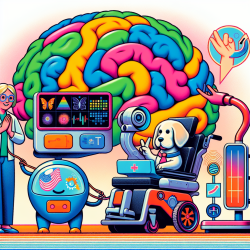Unlocking the Mysteries of Posterior Cortical Atrophy with FDG-PET
As a practitioner in the field of speech-language pathology, understanding the complexities of neurodegenerative disorders is crucial for improving patient outcomes. A recent study titled "Posterior cortical atrophy phenotypic heterogeneity revealed by decoding 18F-FDG-PET" offers valuable insights into the heterogeneity of posterior cortical atrophy (PCA) and how practitioners can leverage these findings to enhance their diagnostic and therapeutic approaches.
The Power of FDG-PET Imaging
The study utilized 18F-fluorodeoxyglucose (FDG)-PET imaging, a sensitive marker for detecting regional brain dysfunction. By applying an unsupervised machine learning algorithm, researchers identified distinct patterns of brain activity, termed "eigenbrains," which capture the inter-individual variability in PCA. These patterns provide a deeper understanding of the disease's heterogeneity, revealing important associations with demographic and clinical data.
Key Findings and Their Implications
The study identified eight eigenbrains that explained over 50% of the variance in FDG-PET uptake among participants. Notably, left and right hemispheric differences accounted for 24% of the variance, highlighting the importance of lateralization in PCA. These findings suggest that practitioners should consider hemispheric dominance when assessing cognitive and neurological symptoms in PCA patients.
- Left Hemispheric Dominance: Associated with aphasia, apraxia, and global cognitive decline.
- Right Hemispheric Dominance: Linked to environmental agnosia and apperceptive prosopagnosia.
Practical Applications for Practitioners
For speech-language pathologists and other practitioners, these findings emphasize the need for a tailored approach to diagnosis and treatment. By understanding the specific brain patterns associated with PCA, practitioners can develop more targeted interventions that address the unique cognitive and neurological challenges faced by each patient.
Additionally, the study's use of machine learning to decode brain imaging data highlights the potential for integrating advanced technologies into clinical practice. Practitioners are encouraged to explore these innovative approaches to enhance their diagnostic accuracy and improve patient outcomes.
Encouraging Further Research
While the study provides valuable insights into PCA, it also underscores the need for further research to refine our understanding of this complex disorder. Practitioners are encouraged to engage in collaborative research efforts and contribute to the growing body of knowledge on PCA and other neurodegenerative conditions.
To read the original research paper, please follow this link: Posterior cortical atrophy phenotypic heterogeneity revealed by decoding 18F-FDG-PET.










